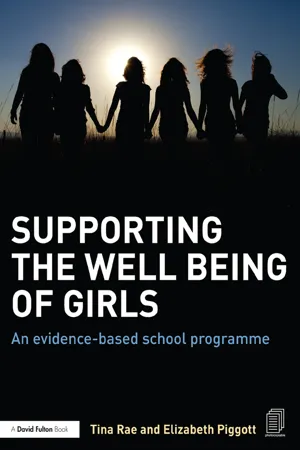![]()
THE PROGRAMME
Resources required
• Flip chart for group rules
• Selection of ‘female-interest’ magazines
• Doughnuts – enough for one per group member
• Thought diaries printed up and bound ready for decoration
• Arts and crafts materials with which to decorate the diaries
The objective of the first session is to communicate the key aims and the contents of the curriculum with the students involved. The expectations of and reasons for participation should also be discussed.
It is important that this communication is shared. Students should be offered the opportunity to communicate their wishes and expectations for the curriculum to the facilitators.
Group rules
It is here that the group rules should be drawn up and recoded (possibly using the format provided (Appendix 1.1)). Start with those set by the practitioners and then invite the students to offer their own. It is important that attention is drawn to these group rules at the beginning of each session. They should be visible at all times so that they can be referred to throughout the session. A set of group rules may include the following statements:
Everyone should try to keep bad language to a minimum.
Everyone should try not to use any of the banned words.
Everyone should ask permission before taking a time out.
Everyone should recognise that what is talked about in these sessions should stay in these sessions.
Everyone needs to listen to each other and not talk over one another.
Everyone needs to try to give ideas and offer solutions.
Everyone must be careful not to criticise others’ ideas but to build upon them.
Talk time
In this first session it is important to emphasise to the students that this interval will become a regular feature of every session. Facilitators may also wish to highlight the importance of ‘chat time’ with other women.
As it is likely that any discussion in this session will focus on the curriculum itself, perhaps the facilitators could frame this talk time in the form of a thought storm activity using the activity sheet provided (Appendix 1.2).
Introduction
This time should be spent welcoming the students to the session. It is likely that on arrival the students will be both apprehensive and inquisitive. In order to reassure them, the rationale behind the inception of the curriculum should be explained and understood. It may be helpful for the facilitators to highlight the following points:
This is a group for girls which will focus upon the key issues and challenges they face.
Topics we will cover include relationships, bullying, self-esteem, stress, self-harm and healthy living.
There will be regular opportunities within these groups to discuss things that concern you within a supportive environment.
Icebreaker
This first icebreaker is titled ‘Which celebrity inspires you the most?’ To begin spread a number of ‘female-interest’ magazines out over the table and prompt the students to pick one image of a celebrity they are inspired by. Proceed round the table, taking it in turns to present the images and discuss the reasoning behind their selection. This activity is intended to ease the students into the session and to encourage them to begin to partake in group discussions.
Core activity (a)
This activity is intended to show the students that participation in this curriculum will also be enjoyable. The ‘Doughnut game’ should be played by both the facilitators and the students. In pairs, one person should attempt to eat a doughnut without licking their lips. Their partner should watch carefully to see how long it takes before they inevitably do so. During feedback the following questions could be considered:
Did you realise you were licking your lips?
Was it difficult to stop licking your lips?
Do you do other things without thinking?
Can you tell us what you do without thinking?
How could you stop yourself doing these things?
Core activity (b)
During the first session this time should be used to introduce the students to their thought diaries (Appendix 1.3). These diaries provide the students with a place to record their thoughts and feelings as the weeks progress. It is advisable to have the diaries printed and bound prior to the session, ready for the students to personalise and decorate. Arts and crafts materials (e.g. pens, glitter, sequins) with which to do this should be provided. A suggested layout for the thought diaries is shown in Appendix 1.3.
Each diary page also includes space for the students to write and record their F.U.F.s for each week. F.U.F. stands for ‘fortunately, unfortunately and fortunately’. In order to complete the F.U.F.s section of their thought diaries the students have to look back over the previous week and identify one positive occurrence. When noting down they should begin their sentence with ‘fortunately’. They then identify one negative occur...
